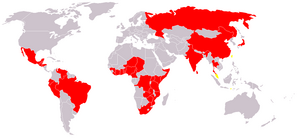Cholera

Cholera (also called Asiatic cholera) is an infectious disease of the gastrointestinal tract caused by the Vibrio cholerae bacterium. These bacteria are typically ingested by drinking water contaminated by improper sanitation or by eating improperly cooked fish, especially shellfish. Symptoms include diarrhea, abdominal cramps, nausea, vomiting, and dehydration. Death is generally due to the dehydration caused by the illness. When left untreated Cholera generally has a high mortality rate. Treatment is typically an aggressive rehydration regimen usually delivered intravenously, which continues until the diarrhea ceases.
- About one million Vibrio cholerae bacteria must be ingested to cause cholera in normally healthy adults, although increased susceptibility may be observed in those with a weakened immune system, individuals with decreased gastric acidity (as from the use of antacids), or those who are malnourished.
- 1,099,882 cases and 10,453 deaths were reported in the Western Hemisphere between January 1991 and July 1995.
- On average, one case of cholera is reported in the United States every week.
Vibrio cholerae causes disease by producing a toxin that disables the GTPase function of G proteins which are part of G protein-coupled receptors in intestinal cells. This has the effect that the G proteins are locked in the "on position" binding GTP (normally, the G proteins quickly return to "off" by hydrolizing GTP to GDP). The G proteins then cause adenylate cyclases to produce large amounts of cyclic AMP (cAMP) which results in the loss of fluid and salts across the lining of the gut.
The resulting diarrhea allows the bacterium to spread to other people under unsanitary conditions.
Although cholera can be life-threatening, it is easily prevented and treated. In the United States, because of advanced water and sanitation systems, cholera is not a major threat. The last major outbreak of cholera in the United States was in 1911. However, everyone, especially travelers, should be aware of how the disease is transmitted and what can be done to prevent it.
Carriers of the cystic fibrosis gene are protected from the severe effects of cholera because they don't lose water as quickly. This explains the high incidence of cystic fibrosis among populations which were formerly exposed to cholera.
Recent genetic research has determined that a person's susceptibility to cholera (and other diarrheas) is affected by their blood type. Those with type O blood are the most susceptible. Those with type AB are the most resistant, virtually immune. Between these two extremes are the A and B blood types, with type A being more resistant than type B.
The scientists with major contributions to fighting cholera are John Snow, who found the link between cholera and drinking water in 1854, and Robert Koch, who identified the bacillus causing the disease.
References:
- Cholera facts from the United States FDA website: http://vm.cfsan.fda.gov/~MOW/chap7.html
External links:
- What is Cholera? (http://www.cdc.gov/ncidod/dbmd/diseaseinfo/cholera_g.htm) (CDC)
- Posen-L:consise description, extended history of epidemics, with timeline (http://www.posen-l.com/Cholera.htm)
- Todar's Online Textbook of Bacteriology: Cholera (http://textbookofbacteriology.net/cholera.html)
- Study on the relationship between blood type and cholera susceptibility (http://www.ncbi.nlm.nih.gov/entrez/query.fcgi?cmd=Retrieve&db=pubmed&dopt=Abstract&list_uids=8035040) (Medline)